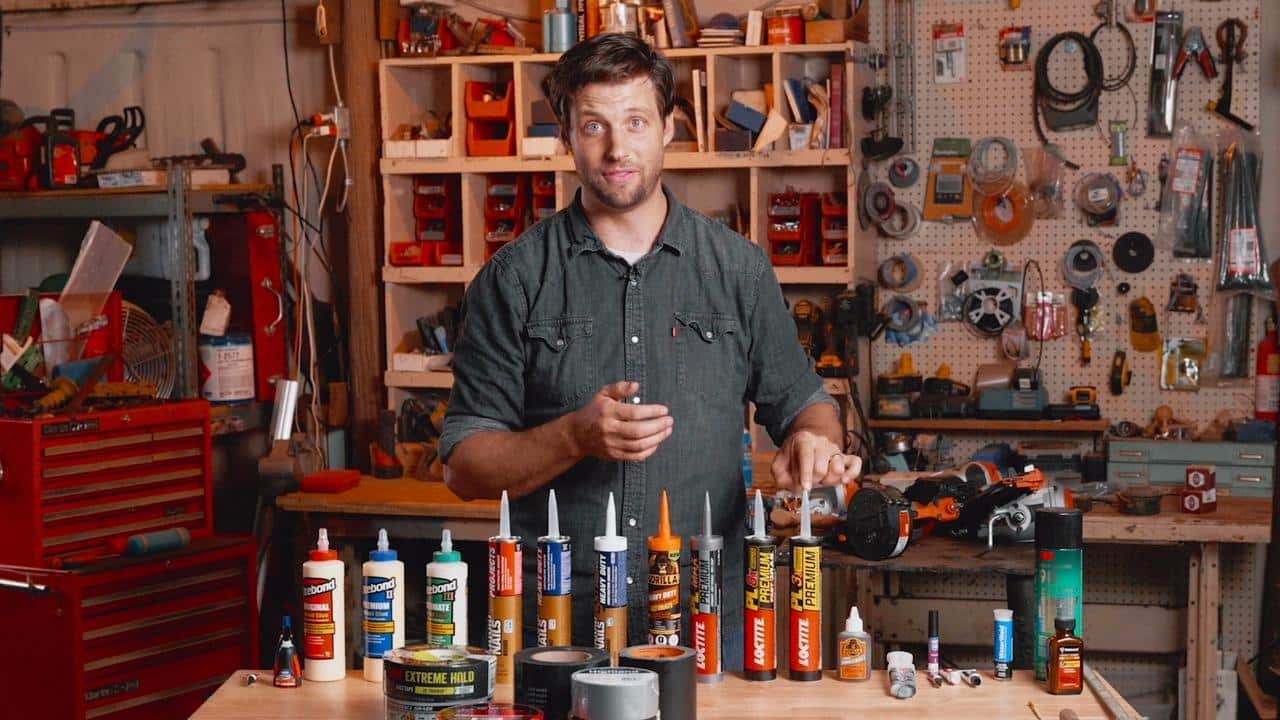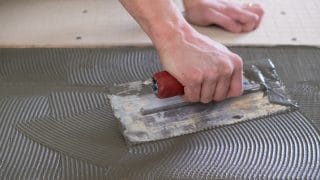
Polyurethanes, polymeric compounds that are close cousins of epoxies, were first discovered in 1937 by the German chemist Dr. Otto Bayer. They are commonly encountered as foams, for example, as insulating foam for mattresses and molded foam used in surfboards, but they have also been used as adhesives throughout much of the world since the 1950s.
Polyurethane glue entered the American market until 1994 when the Gorilla Glue company began selling polyurethane glues. (For many Americans, Gorilla Glue is the more familiar name for polyurethane than its chemical one.) Over the last two decades, it has become one of the most common go-to construction adhesives that contractors depend upon for all sorts of jobs. Popular brands include Titebond and Loctite.
Similar to cyanoacrylates, polyurethane adhesives require a chemical reaction in order to cure, and that reaction is set off by moisture.
“If you’re gluing concrete to wood, no problem,” explains builder and instructor Jordan Smith. “Concrete has moisture; wood’s got moisture.” When one of the substances is non-porous, however, some extra moisture is required. “Make sure that you moisten one side of your joint using just a little spritz bottle,” Smith says, “then apply glue to the other side and stick them together tight.” If you are using polyurethane across large surfaces, like drywall panels, you can spread the foam into place using trowels and other hand tools.
When to Use Polyurethane Glue
While the application of polyurethane as an adhesive is not especially complicated (though it can be a little messier than some other glues), first you need to know its advantages and disadvantages when compared to wood glue, epoxies, and other options.
Advantages of polyurethane adhesives
- Compatibility. Polyurethane adhesives are truly multi-purpose products and can be used to bond a variety of building materials: wood, glass, concrete, metals, carpets, and more. If you are bonding two nonporous materials—like metal on metal—just make sure to moisten the surfaces before you glue them.
- Waterproof. Polyurethane bonds are waterproof, making it a good adhesive choice for outdoor projects. (Though they will not withstand being submerged for extended periods.)
- Paintable. While some ordinary adhesives’ performance will be impaired if they are painted, polyurethane can be painted after it has set.
- Set time. While clamping is recommended, as a general rule polyurethane has a shorter setting time than epoxies.
Why don’t structures fall down or come apart? Learn all about the stuff that holds building materials together in the MT Copeland online Fasteners and Adhesives course. Taught by professional builder Jordan Smith, the course covers topics ranging from nails and screws to glues and epoxies.
Disadvantages of polyurethane adhesives
- Strength. There are a wide range of polyurethane construction adhesives available, with varying strengths. Some are less strong than epoxies and PVAs like yellow glue, so you’ll want to make sure the polyurethane you are using is up to the task. While cheaper brands may not form as strong bonds, high performance polyurethane products, like Loctite’s PL Premium to pick one example, are as strong as or even stronger than other common construction adhesives.
- Durability. In some cases, polyurethanes’ tendency to absorb water make these bonds less durable. However constant advances in polyurethane formulas and the addition of other agents has helped make these bonds more durable.
- Short shelf life. Because polyurethane will absorb water from the surrounding atmosphere and begin to cure, it has a short shelf life of one year.
- Toxicity. Polyurethane includes known carcinogens and you will want to assure proper ventilation when applying any polyurethane products, including adhesive. You’ll also want to wear gloves and avoid contact with skin.
- Variable set times. Because polyurethane requires moisture in order to cure and set, it can be slower when used in especially dry areas.
4 Tips for Using Polyurethane Glue
1. Clean the Surface
At a minimum you will want to assure that the surface is free of dirt and debris, but oils can also interfere with polyurethane’s bonding process. Cleaning the surface with soap and water can eliminate oils.
Polyurethanes, polymeric compounds that are close cousins of epoxies, were first discovered in 1937 by the German chemist Dr. Otto Bayer. They are commonly encountered as foams, for example, as insulating foam for mattresses and molded foam used in surfboards, but they have also been used as adhesives throughout much of the world since the 1950s.
Polyurethane glue entered the American market until 1994 when the Gorilla Glue company began selling polyurethane glues. (For many Americans, Gorilla Glue is the more familiar name for polyurethane than its chemical one.) Over the last two decades, it has become one of the most common go-to construction adhesives that contractors depend upon for all sorts of jobs. Popular brands include Titebond and Loctite.
Similar to cyanoacrylates, polyurethane adhesives require a chemical reaction in order to cure, and that reaction is set off by moisture.
“If you’re gluing concrete to wood, no problem,” explains builder and instructor Jordan Smith. “Concrete has moisture; wood’s got moisture.” When one of the substances is non-porous, however, some extra moisture is required. “Make sure that you moisten one side of your joint using just a little spritz bottle,” Smith says, “then apply glue to the other side and stick them together tight.” If you are using polyurethane across large surfaces, like drywall panels, you can spread the foam into place using trowels and other hand tools.
When to Use Polyurethane Glue
While the application of polyurethane as an adhesive is not especially complicated (though it can be a little messier than some other glues), first you need to know its advantages and disadvantages when compared to wood glue, epoxies, and other options.
Advantages of polyurethane adhesives
- Compatibility. Polyurethane adhesives are truly multi-purpose products and can be used to bond a variety of building materials: wood, glass, concrete, metals, carpets, and more. If you are bonding two nonporous materials—like metal on metal—just make sure to moisten the surfaces before you glue them.
- Waterproof. Polyurethane bonds are waterproof, making it a good adhesive choice for outdoor projects. (Though they will not withstand being submerged for extended periods.)
- Paintable. While some ordinary adhesives’ performance will be impaired if they are painted, polyurethane can be painted after it has set.
- Set time. While clamping is recommended, as a general rule polyurethane has a shorter setting time than epoxies.
Why don’t structures fall down or come apart? Learn all about the stuff that holds building materials together in the MT Copeland online Fasteners and Adhesives course. Taught by professional builder Jordan Smith, the course covers topics ranging from nails and screws to glues and epoxies.
Disadvantages of polyurethane adhesives
- Strength. There are a wide range of polyurethane construction adhesives available, with varying strengths. Some are less strong than epoxies and PVAs like yellow glue, so you’ll want to make sure the polyurethane you are using is up to the task. While cheaper brands may not form as strong bonds, high performance polyurethane products, like Loctite’s PL Premium to pick one example, are as strong as or even stronger than other common construction adhesives.
- Durability. In some cases, polyurethanes’ tendency to absorb water make these bonds less durable. However constant advances in polyurethane formulas and the addition of other agents has helped make these bonds more durable.
- Short shelf life. Because polyurethane will absorb water from the surrounding atmosphere and begin to cure, it has a short shelf life of one year.
- Toxicity. Polyurethane includes known carcinogens and you will want to assure proper ventilation when applying any polyurethane products, including adhesive. You’ll also want to wear gloves and avoid contact with skin.
- Variable set times. Because polyurethane requires moisture in order to cure and set, it can be slower when used in especially dry areas.
4 Tips for Using Polyurethane Glue
1. Clean the Surface
At a minimum you will want to assure that the surface is free of dirt and debris, but oils can also interfere with polyurethane’s bonding process. Cleaning the surface with soap and water can eliminate oils.
2. Rough It Up
A rougher surface can help polyurethane, as well as other glues, achieve a tighter bond and more holding power. Sand blasting metals or using sandpaper on other surfaces will help achieve a tighter bond.
3. Keep Viscosity in Mind
Consider the surface you are working with and whether a polyurethane with a higher or lower viscosity will make the project easier. As a rule, glues with higher viscosities work better with vertical surfaces, when the glue running may be an issue.
4. Clamp It
The foam produced by some polyurethane adhesives when they are curing can push the objects being glued apart. Properly clamping the two surfaces together can minimize this risk.
MT Copeland offers video-based online classes that give you a foundation in construction fundamentals with real-world applications. Classes include professionally produced videos taught by practicing craftspeople, and supplementary downloads like quizzes, blueprints, and other materials to help you master the skills.







